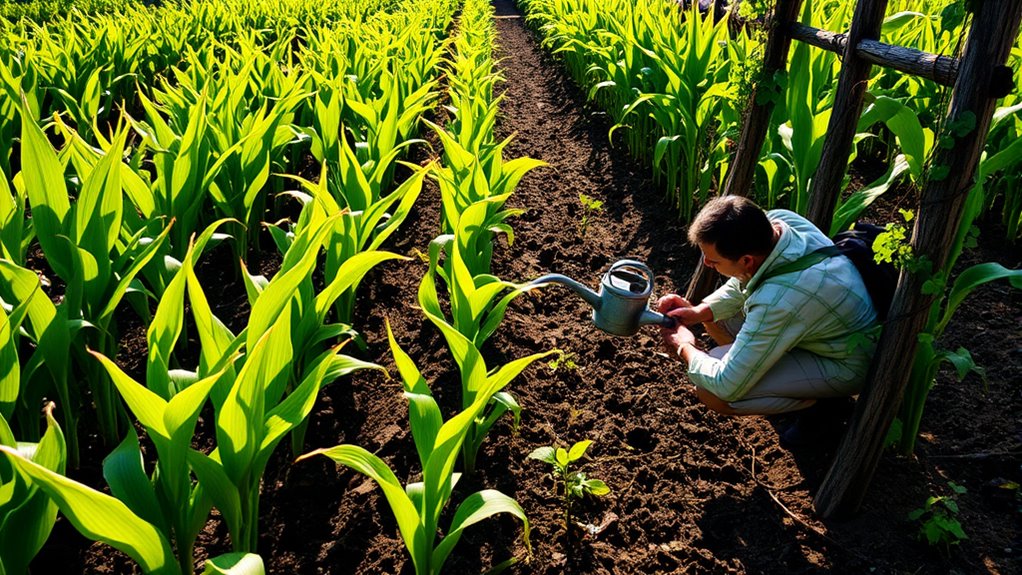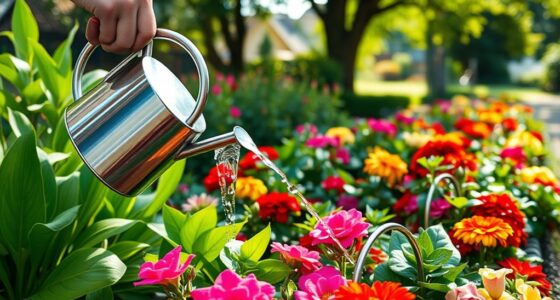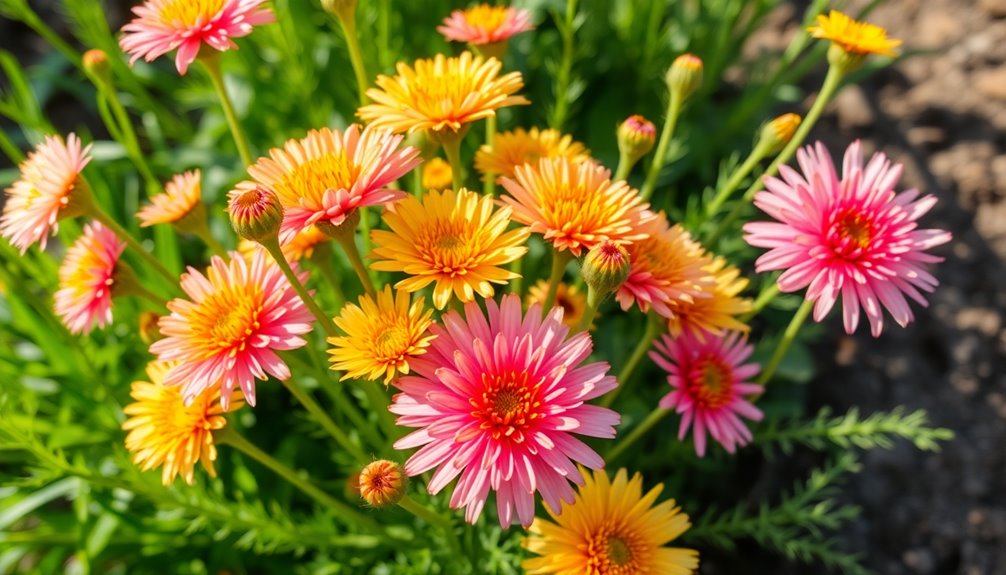To grow corn in small plots, choose early and dwarf varieties like Golden Bantam or Kandy Korn for quick yields and sweetness. Prepare your soil with compost and organic fertilizers, spacing plants about 15-20 cm apart. Use hill planting with 5 to 9 seeds per cluster for better pollination. Plant in blocks to enhance wind flow and consider hand pollination if needed. Effective pest management and crop rotation are essential for healthy crops. Keep on exploring more tips for success!
Key Takeaways
- Choose early and dwarf sweet corn varieties like Golden Bantam that thrive in small spaces and yield multiple ears per plant.
- Employ the hill planting technique, grouping 5 to 9 seeds per hill and thinning to about 6 plants for better pollination.
- Plant corn in blocks of 20-25 plants and at least 4-5 short rows to enhance wind pollination and stability.
- Incorporate compost or well-rotted manure into the soil to boost fertility and consider topdressing with organic fertilizers during the growing season.
- Monitor for pests and diseases regularly, using organic methods and crop rotation to maintain a healthy corn crop.
Choosing the Right Corn Varieties for Small Spaces
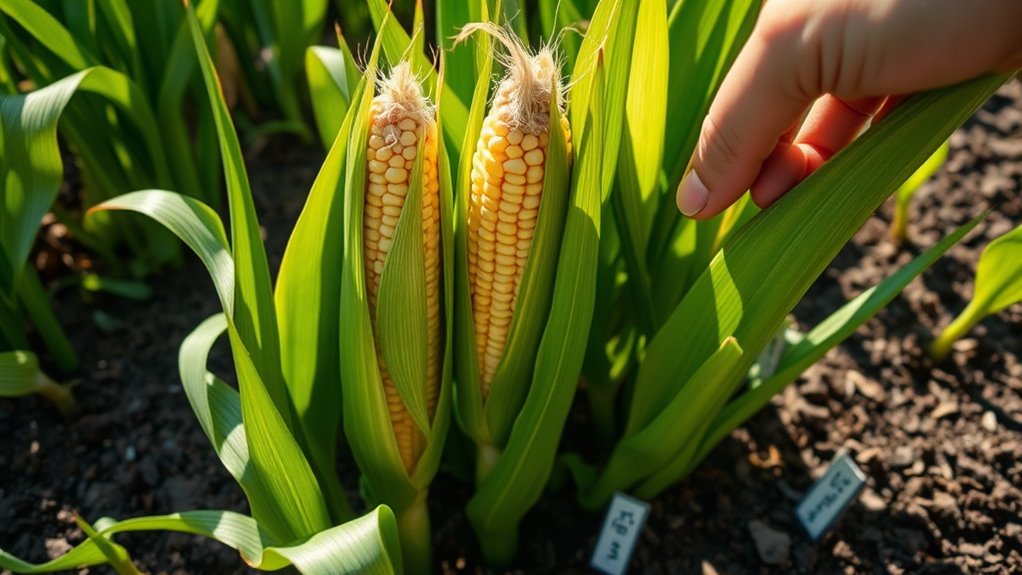
When you're limited on space but still want to enjoy homegrown corn, choosing the right varieties is essential. For small spaces, early and dwarf sweet corn varieties like Golden Bantam and Jolly Roger are perfect. They yield multiple ears per plant and mature quickly, which is great for your limited garden.
Sugar-enhanced options such as Kandy Korn and Butter and Sugar offer superior sweetness and maintain their flavor longer after harvest. To maximize your small plot, plant corn in blocks of 20-25 plants for better wind pollination.
Space your corn plants about 15-20 cm apart to optimize nutrient access and guarantee effective pollination. If you're short on ground space, consider container gardening with larger pots to grow sweet corn successfully.
Soil Preparation and Fertilization Techniques
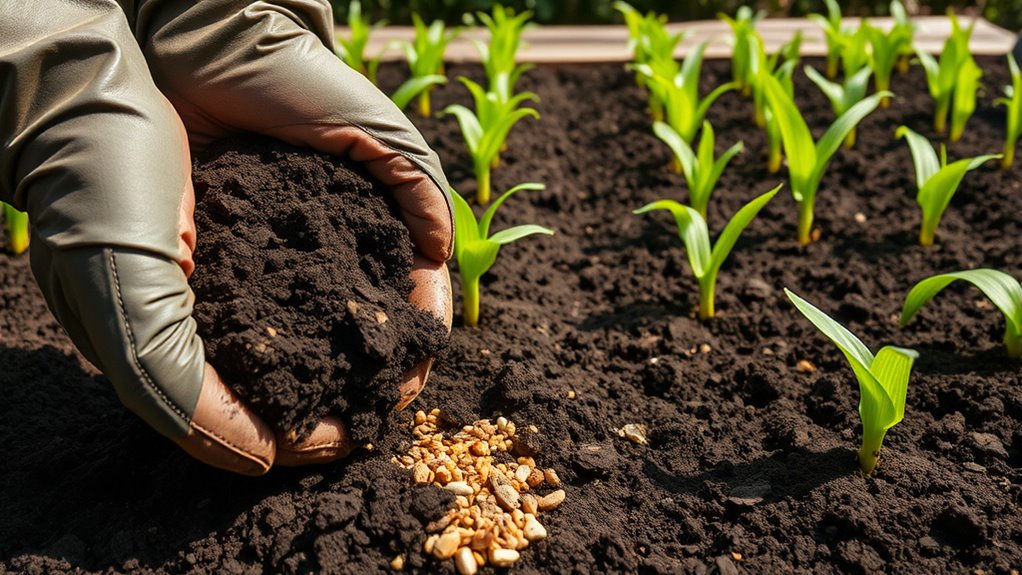
After you've selected the right corn varieties for your small space, preparing the soil is your next step to guarantee a successful harvest.
Start by incorporating 2 inches of compost or well-rotted manure into the soil, enhancing soil fertility and providing essential nutrients for your heavy-feeding corn. Conduct annual soil tests to check nutrient levels and adjust as needed for ideal pH.
Incorporate 2 inches of compost or well-rotted manure to boost soil fertility for your corn.
Throughout the growing season, use fertilization techniques like topdressing with compost or organic fertilizers to support vigorous growth. Combine slow-release fertilizers with liquid feedings, such as compost tea and seaweed extract, to meet your corn's nutritional demands.
Finally, mulch with wood chips or fallen leaves to retain moisture and enrich the soil over time.
Effective Planting Methods for Optimal Growth

When planting corn, using the hill method can boost your yield by ensuring proper spacing and pollination.
You should also consider succession planting to stagger your harvest and maximize fresh corn throughout the season.
Hill Planting Technique
The hill planting technique offers a smart way to maximize corn growth in limited spaces. By grouping 5 to 9 seeds per hill and thinning to about 6 plants, you enhance pollination efficiency in your small plot.
Space hills 12 to 18 inches apart and prepare nutrient-rich soil with compost and organic fertilizer for healthy corn stalks. This close-knit planting enables better wind-pollination, ensuring effective pollen transfer.
Each hill can yield around two ears of corn, with reports showing up to 100 ears from just 8 hills containing 4 plants each. To boost your yield, water consistently, providing at least an inch of water weekly, and monitor your plants' growth for ideal results.
Successive Planting Strategies
Successive planting strategies can be a game changer for your corn cultivation, allowing you to enjoy fresh corn throughout the growing season. By planting corn every 2-3 weeks, you can stagger harvest times, ensuring a continuous supply of delicious corn kernels.
In your small garden, consider planting in blocks of 4-5 short rows instead of single long rows; this arrangement improves pollination and supports plant stability. Use the hill method, planting 5 to 9 seeds per hill and thinning to about 6 plants for ideal growth.
Incorporate companion planting techniques, like the Three Sisters method, to enhance soil health. Finally, keep an eye on soil moisture, ensuring your corn receives at least an inch of water weekly for successful successive planting.
Pollination Strategies for Maximum Yield

Effective pollination is vital for maximizing corn yield, so employing the right strategies can make all the difference.
Start by planting corn in blocks of at least 4-5 short rows, which enhances wind flow and increases pollen transfer. The hill planting method, where you sow 5 to 9 seeds per hill, also clusters plants closely for better fertilization chances.
If conditions are unfavorable, don't hesitate to hand pollinate to guarantee complete pollination in your small plots. Maintain at least 18 inches between rows to promote airflow and prevent overcrowding, which can hinder kernel development.
Finally, monitor tassel emergence and silk production closely, as synchronized timing is essential for successful corn growing and achieving maximum yield.
Managing Pests and Diseases in Corn Cultivation

While managing pests and diseases can seem intimidating, taking proactive steps guarantees healthier corn crops and better yields.
Start by implementing crop rotation to reduce pest issues and diseases. Regularly inspect your corn for signs of damage, especially from earworms, which can harm young kernels. Timely monitoring allows for interventions like organic insecticides to manage these pests effectively.
Also, keep an eye out for corn smut; while it can affect kernels, it's edible, so decide whether to harvest or manage it.
To deter raccoons from your ripening sweet corn, use netting or barriers. By maintaining good sanitation practices, you'll create a healthier environment for your corn and enhance overall productivity.
Harvesting Corn: Indicators of Ripeness
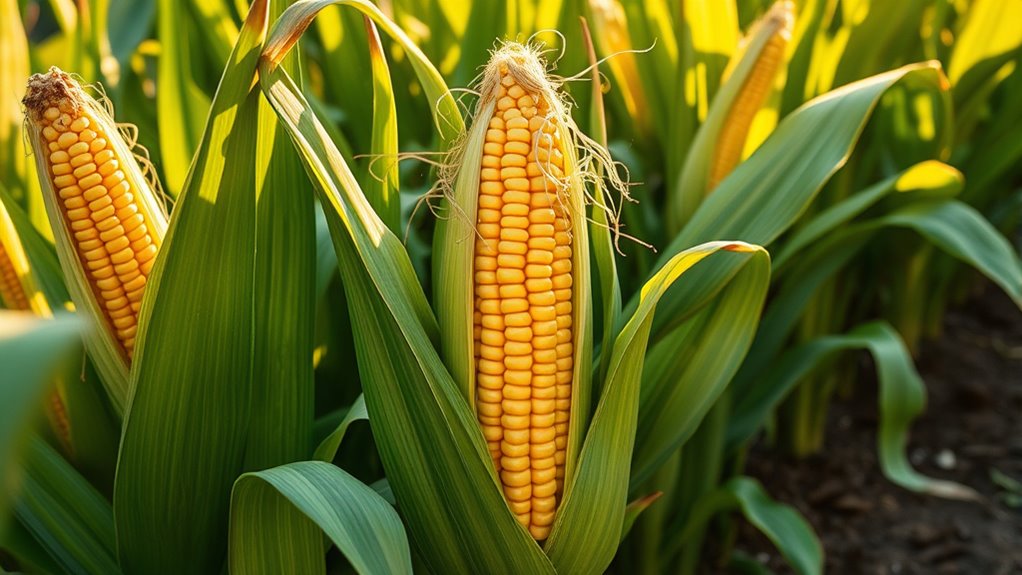
When it comes to harvesting corn, you'll want to look for key indicators of ripeness.
Check for dark brown tassels and firm kernels, then test a kernel by piercing it for that creamy liquid.
Timing is everything, so make sure to harvest when the ears are plump and leaning away from the stalk for the best flavor.
Visual Signs of Ripeness
To determine if your corn is ripe for harvest, look for specific visual signs that indicate maturity.
Check the tassels—when they turn dark brown or black, it's a good indicator that ripeness is near. The ear of corn should feel fat and firm, with the silk at the tip becoming brown and dry. This signals it's time to pick.
You'll also notice the ears leaning away from the main stalk, a clear sign of readiness. Regularly inspect your field of corn, especially as the upper ear typically ripens first.
Finally, if you pierce a kernel with your fingernail and creamy liquid comes out, it's a strong indication that your corn is ready for harvest.
Kernel Texture Test
How can you be sure your corn is truly ripe? To perform the kernel texture test, simply pierce a kernel with your fingernail. If a milky, creamy liquid emerges, your corn is ready for harvesting.
Ideally, you'll want to pick sweet corn about 2-3 weeks after flowering, when the silk turns brown and dry. Ripe ears should feel firm and plump, often with two ears per stalk, where the upper ear ripens first.
It's essential to harvest as soon as you reach harvest maturity; delaying can lead to starchy kernels and a loss of sweetness. Don't forget to check the color of the tassels—dark brown or black indicates this is the year of corn to grow and enjoy!
Timing for Harvesting
After confirming your corn's ripeness with the kernel texture test, it's time to focus on the ideal timing for harvesting. Corn is typically ready 2-3 weeks after flowering, marked by dark brown tassels. Ripe ears feel firm with brown, dry silk at the tip.
Here's a quick guide for harvesting:
| Indicator | Description |
|---|---|
| Ear Firmness | Ears should feel plump and firm |
| Silk Condition | Brown, dry silk at the tip |
| Kernel Test | Creamy liquid when pierced |
Harvest promptly—sweet corn's flavor diminishes quickly after picking. Remember, the upper ear matures first, so check multiple ears for optimal ripeness. Enjoy your fresh sweet corn!
Frequently Asked Questions
How to Plant a Small Plot of Corn?
To plant a small plot of corn, start by preparing the soil with compost or manure.
Then, choose a sunny location and make certain the soil warms up to at least 60°F.
Plant your corn in blocks of short rows for better pollination.
Use the hill method by making small holes, dropping a few seeds in each, and later thinning them out.
Keep an eye on moisture levels, watering weekly to guarantee healthy growth.
What Not to Do When Growing Corn?
Did you know that about 25% of corn yield loss can be attributed to poor planting practices?
When you're growing corn, don't plant in single rows; it hampers pollination. You've gotta maintain proper spacing to avoid competition for nutrients.
Don't neglect your soil health—corn's a heavy feeder! Make sure to keep the soil moist, especially early on, and protect your plants from pests like birds and rabbits.
Do Corn Plants Like to Be Crowded?
Corn plants don't like to be crowded. When you plant them too close together, it can lead to poor pollination and fewer ears developing, resulting in stunted kernels.
For the best growth, make sure you space your corn about 6-7.5 inches apart within rows and 15-20 inches between rows. This spacing allows better air circulation and sunlight access, which is essential for healthy, productive plants and maximizing your yield.
What Is the Secret to Growing Corn?
Imagine standing in a lush, green field, tall corn stalks swaying in the breeze. The secret to growing corn lies in your hands.
You need rich, well-amended soil and consistent watering—think of it as your corn's lifeline. Plant in blocks for better pollination, and don't shy away from succession planting to stretch out your harvest.
Finally, protect those young plants from pests and frost; they're your ticket to a bountiful crop.
Conclusion
In the journey of growing corn in small plots, you've navigated the essential steps from choosing the right varieties to harvesting at just the right moment. Like a painter with a vibrant palette, each choice you make adds color and richness to your garden. With proper care and attention, your corn will thrive, promising bountiful rewards. So roll up your sleeves, embrace the process, and watch as your labor transforms into a golden harvest that delights the senses.

